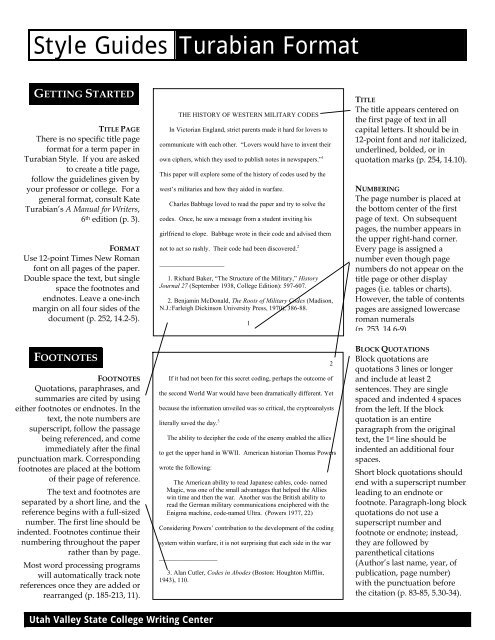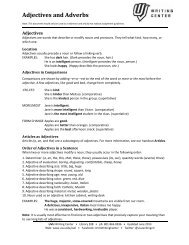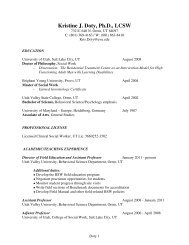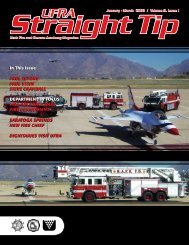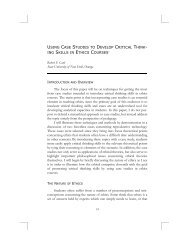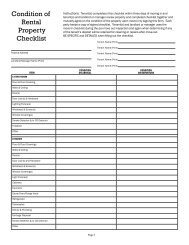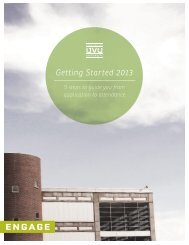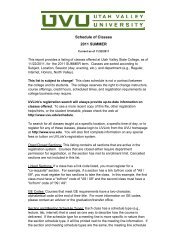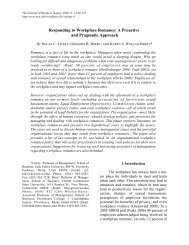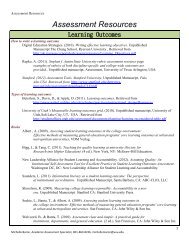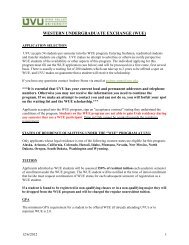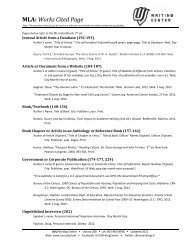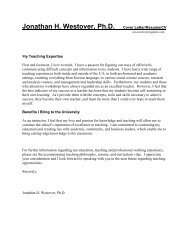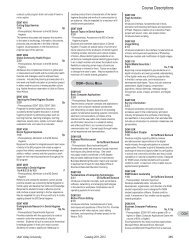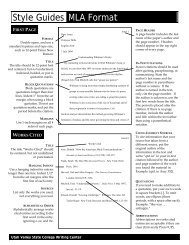Style Guides Turabian Format - UVU
Style Guides Turabian Format - UVU
Style Guides Turabian Format - UVU
Create successful ePaper yourself
Turn your PDF publications into a flip-book with our unique Google optimized e-Paper software.
<strong>Style</strong> <strong>Guides</strong> <strong>Turabian</strong> <strong>Format</strong><br />
G<br />
GETTING STARTED<br />
TITLE PAGE<br />
There is no specific title page<br />
format for a term paper in<br />
<strong>Turabian</strong> <strong>Style</strong>. If you are asked<br />
to create a title page,<br />
follow the guidelines given by<br />
your professor or college. For a<br />
general format, consult Kate<br />
<strong>Turabian</strong>’s A Manual for Writers,<br />
6 th edition (p. 3).<br />
FORMAT<br />
Use 12-point Times New Roman<br />
font on all pages of the paper.<br />
Double space the text, but single<br />
space the footnotes and<br />
endnotes. Leave a one-inch<br />
margin on all four sides of the<br />
document (p. 252, 14.2-5).<br />
F<br />
FOOTNOTES<br />
FOOTNOTES<br />
Quotations, paraphrases, and<br />
summaries are cited by using<br />
either footnotes or endnotes. In the<br />
text, the note numbers are<br />
superscript, follow the passage<br />
being referenced, and come<br />
immediately after the final<br />
punctuation mark. Corresponding<br />
footnotes are placed at the bottom<br />
of their page of reference.<br />
The text and footnotes are<br />
separated by a short line, and the<br />
reference begins with a full-sized<br />
number. The first line should be<br />
indented. Footnotes continue their<br />
numbering throughout the paper<br />
rather than by page.<br />
Most word processing programs<br />
will automatically track note<br />
references once they are added or<br />
rearranged (p. 185-213, 11).<br />
Utah Valley State College Writing Center<br />
THE HISTORY OF WESTERN MILITARY CODES<br />
In Victorian England, strict parents made it hard for lovers to<br />
communicate with each other. “Lovers would have to invent their<br />
own ciphers, which they used to publish notes in newspapers.” 1<br />
This paper will explore some of the history of codes used by the<br />
west’s militaries and how they aided in warfare.<br />
Charles Babbage loved to read the paper and try to solve the<br />
codes. Once, he saw a message from a student inviting his<br />
girlfriend to elope. Babbage wrote in their code and advised them<br />
not to act so rashly. Their code had been discovered. 2<br />
____________________<br />
1. Richard Baker, “The Structure of the Military,” History<br />
Journal 27 (September 1938, College Edition): 597-607.<br />
2. Benjamin McDonald, The Roots of Military Codes (Madison,<br />
N.J.:Farleigh Dickinson University Press, 1970), 386-88.<br />
1<br />
If it had not been for this secret coding, perhaps the outcome of<br />
the second World War would have been dramatically different. Yet<br />
because the information unveiled was so critical, the cryptoanalysts<br />
literally saved the day. 3<br />
The ability to decipher the code of the enemy enabled the allies<br />
to get the upper hand in WWII. American historian Thomas Powers<br />
wrote the following:<br />
The American ability to read Japanese cables, code- named<br />
Magic, was one of the small advantages that helped the Allies<br />
win time and then the war. Another was the British ability to<br />
read the German military communications enciphered with the<br />
Enigma machine, code-named Ultra. (Powers 1977, 22)<br />
Considering Powers’ contribution to the development of the coding<br />
system within warfare, it is not surprising that each side in the war<br />
__________________<br />
3. Alan Cutler, Codes in Abodes (Boston: Houghton Mifflin,<br />
1943), 110.<br />
2<br />
TITLE<br />
The title appears centered on<br />
the first page of text in all<br />
capital letters. It should be in<br />
12-point font and not italicized,<br />
underlined, bolded, or in<br />
quotation marks (p. 254, 14.10).<br />
NUMBERING<br />
The page number is placed at<br />
the bottom center of the first<br />
page of text. On subsequent<br />
pages, the number appears in<br />
the upper right-hand corner.<br />
Every page is assigned a<br />
number even though page<br />
numbers do not appear on the<br />
title page or other display<br />
pages (i.e. tables or charts).<br />
However, the table of contents<br />
pages are assigned lowercase<br />
roman numerals<br />
(p 253 14 6-9)<br />
BLOCK QUOTATIONS<br />
Block quotations are<br />
quotations 3 lines or longer<br />
and include at least 2<br />
sentences. They are single<br />
spaced and indented 4 spaces<br />
from the left. If the block<br />
quotation is an entire<br />
paragraph from the original<br />
text, the 1 st line should be<br />
indented an additional four<br />
spaces.<br />
Short block quotations should<br />
end with a superscript number<br />
leading to an endnote or<br />
footnote. Paragraph-long block<br />
quotations do not use a<br />
superscript number and<br />
footnote or endnote; instead,<br />
they are followed by<br />
parenthetical citations<br />
(Author’s last name, year, of<br />
publication, page number)<br />
with the punctuation before<br />
the citation (p. 83-85, 5.30-34).
<strong>Style</strong> <strong>Guides</strong> <strong>Turabian</strong> <strong>Format</strong><br />
ENDNOTES<br />
ENDNOTES<br />
Rather than footnotes, your<br />
instructor may require endnotes.<br />
These are found at the<br />
conclusion of the paper and<br />
serve the same purpose as<br />
footnotes. In-text citations still<br />
appear as superscript numerals,<br />
but the actual entries are found<br />
at the end of the paper, preceded<br />
by full-sized numbers with<br />
periods. As with footnotes, the<br />
first line is indented.<br />
Both endnotes and footnotes<br />
must contain information about<br />
the source. They may also<br />
provide further information or<br />
insight that would distract from<br />
the flow of the paper but still be<br />
relevant to the topic<br />
(p. 13, 1.46; 118, 8.2;<br />
and chapter 11)<br />
B<br />
BIBLIOGRAPHY<br />
BIBLIOGRAPHY<br />
In addition to endnotes or<br />
footnotes, a bibliography is<br />
required. The bibliography<br />
comes after endnotes and should<br />
list all sources that were looked<br />
at or consulted, whether or not<br />
they are referenced in the paper.<br />
The title should be centered and<br />
in all capital letters but not<br />
underlined, italicized, or bolded<br />
(p. 167, 9.7; and chapter 11).<br />
HANGING INDENT<br />
Use a hanging indent for<br />
entries longer than one line.<br />
Indent 1/2’’ from the set<br />
margins after the first line of<br />
each entry (p. 167, 9.9-10).<br />
Utah Valley State College Writing Center<br />
Thus we see the relative importance of coding within the military.<br />
Though codes have proven beneficial to lovers, they have also<br />
proved fatal for enemies of war. Yet codes will forever add to the<br />
mysteries of military warfare.<br />
__________________<br />
1. Marshall Savage, Culture and Practical Reason (Chicago:<br />
University of Chicago Press, 1976) 88.<br />
2. Ibid, 89.<br />
3. A reason why many codes have been broken is that people<br />
have gotten much more intelligent in recent years. While<br />
education opportunities have proliferated, IQ levels have also<br />
risen with the decreased infant mortality rate of women. While<br />
history is the supreme discipline, it is wise to remember that<br />
value can be found in “decoding” other academic disciplines.<br />
(Frank Graves, The Living Principle: “History” as a Discipline<br />
of Thought [London: Chatto & Windus, 1975], 12).<br />
4. Savage, 144.<br />
5. Savage, Codes in Military History, 66.<br />
BIBLIOGRAPHY<br />
Atomic Energy Policy in France under the Fourth<br />
Republic. Princeton: Princeton University Press, 1965.<br />
Cutler, Alan. “The War-Time Reliability of Interstate<br />
Alliances, 1816-1965.” Paper delivered at the<br />
Sixteenth Annual Conference of the International<br />
Studies Association, Washington, D.C. 19-22 February<br />
1975.<br />
Savage, Marshall. The Foundations of Codes. New<br />
York: Dover, 1972.<br />
The Dispersion of Nuclear Weapons Strategy and Politics.<br />
New York: Columbia University Press, 1964.<br />
Washington, George. The George Washington Papers.<br />
Library of Congress. Available at<br />
http://memory.loc.gov/ammem/gwhtml/gwseries1.ht<br />
ml#D, accessed 1 Mar. 2006.<br />
10<br />
USING IBID.<br />
Within footnotes or endnotes,<br />
identical source information<br />
need not be repeated. The<br />
abbreviation “Ibid.” indicates<br />
that the note refers to the same<br />
information as the previous<br />
reference. Use it to replace the<br />
author’s name, the title, and<br />
any other identical<br />
information. If the note refers<br />
to a different page number,<br />
include the correct page<br />
number (p. 138-39, 8.85-87).<br />
SHORTENED REFERENCES<br />
If an author’s work has already<br />
been referenced but does not<br />
immediately precede the note<br />
in question, simply list the<br />
author’s last name and the<br />
page number. If more than one<br />
work by the author is cited<br />
within the document, also<br />
include an abbreviated title (p.<br />
139-41, 8.88-96.).<br />
ALPHABETICAL ORDER<br />
Arrange bibliographical entries<br />
in alphabetical order by the<br />
author’s last name. If there is<br />
no author for a work, list it<br />
alphabetically by the title<br />
(excluding the, a, and an)<br />
SPACING<br />
Each entry should be single<br />
spaced, with double spacing<br />
between entries (p. 167, 9.8).
<strong>Style</strong> <strong>Guides</strong> <strong>Turabian</strong> <strong>Format</strong><br />
CITATION GUIDELINES<br />
Papers written in <strong>Turabian</strong> format require both endnotes or footnotes and a Bibliography page. The<br />
information in footnotes and endnotes should follow the same format, but the bibliography format is<br />
slightly different. Use the following formats for the most common types of sources. In general, names are<br />
cited as they appear in the author’s text, such as including middle name or initial if provided.<br />
N = Note <strong>Format</strong> and B = Bibliography <strong>Format</strong>.<br />
NOTE: The following list includes the most common types of sources. For further information, consult chapters 11 and 12<br />
of Kate <strong>Turabian</strong>’s A Manual for Writers, 6th edition.<br />
BOOK BY A SINGLE AUTHOR (P. 187, 11.3)<br />
N First Name Last Name, Title (Location: Publisher, Year), pages.<br />
Frank R. Wilson, The Hand: How Its Use Shapes the Brain, Language, and Human Culture (New York:<br />
Pantheon, 1998), 14-21.<br />
B Last Name, First Name. Title. Location: Publisher, Year.<br />
Wilson, Frank R. The Hand: How Its Use Shapes the Brain, Language, and Human Culture. New York:<br />
Pantheon, 1998.<br />
BOOK BY TWO AUTHORS (P. 188, 11.4)<br />
N First Name Last Name and First Name Middle Last Name, Title (Location: Publisher, Year), pages.<br />
Roger L. Welsch and Linda K. Welsch, Cather's Kitchens: Foodways in Literature and Life (Lincoln:<br />
University of Nebraska, 1987), 57-72.<br />
B Last Name, First Name, Middle, and First Name, Middle, Last Name. Title. Location: Publisher,<br />
Year.<br />
Welsch, Roger L., and Linda K. Welsch. Cather's Kitchens: Foodways in Literature and Life.<br />
Lincoln: University of Nebraska, 1987.<br />
ELECTRONIC DOCUMENT (P. 210, 11.57)<br />
<strong>Turabian</strong> does not address specific Internet sources, but it does give some basic guidelines for electronic<br />
documents. In general, begin by using the formats on this sheet for the appropriate type of document it is<br />
(article, newspaper, etc). Then list any relevant web information (date accessed, website, database name,<br />
etc.) that would help your reader locate the source. Also indicate the type of electronic medium (Internet,<br />
CD-ROM), etc). These are only some recommended ways of citing internet sources.<br />
N First Name Last Name, Title, Organization, or Web Site, type of electronic medium, access date.<br />
Richard Morningside, “Georgia County Agrees to Remove Ten Commandments Display from<br />
Courthouse,” American Civil Liberties Union, Internet, available from<br />
http://www.aclu.org/religion/tencomm/20163prs20050719.html, accessed 4 March 2006.<br />
B Last Name First Name, Title, Organization, or Web Site, type of electronic medium, access date.<br />
Morningside, Richard. “Georgia County Agrees to Remove Ten Commandments Display from<br />
Courthouse.” American Civil Liberties Union. Internet. Available from<br />
http://www.aclu.org/religion/tencomm/20163prs20050719.html, accessed 4 March 2006.<br />
Utah Valley State College Writing Center
<strong>Style</strong> <strong>Guides</strong> <strong>Turabian</strong> <strong>Format</strong><br />
BOOK WITH NO AUTHOR GIVEN (P. 189, 11.7)<br />
N Title (Location: Publisher, [Year]), Pages.<br />
A Guide to Our Federal Lands (Washington: Natl. Geographic Soc., [1984]), 96.<br />
B Title. Location: Publisher, [Year].<br />
A Guide to Our Federal Lands. Washington: Natl. Geographic Soc., [1984].<br />
TEXT IN COLLECTED WORKS (P. 127, 8.42; P.191, 11.13)<br />
N Author’s First Name Last Name, “Title of Text,” in Title of Collected Works, ed. Editor’s First Name<br />
Last Name (Location: Publisher, Year), pages.<br />
Mary Beach, “The Domestic Realm,” in Separate Worlds, ed. Hanna Papnanek (Delhi: Chanakya,<br />
1982), 115.<br />
B Last Name, First Name. “Title of Text.” In Title of Collected Works, ed. First Name Last Name, pages.<br />
Location: Publisher, Year.<br />
Beach, Mary. “The Domestic Realm.” In Separate Worlds, ed. Hanna Papnanek, 115. Delhi: Chanakya,<br />
1982.<br />
ARTICLE IN A NEWSPAPER (P. 204, 11.44)<br />
N First Name Last Name, “Title of Article,” Title of Newspaper, Day Month Year, section number,<br />
p. pages.<br />
Tyler Marshal, “100 th Birthday of Stalin Celebrated,” Los Angeles Times, 9 December 1979, sec.1A, p.<br />
3.<br />
B Newspapers are rarely listed separately in a bibliography. If a newspaper is cited only once or twice,<br />
a note or parenthetical reference in the text is sufficient.<br />
ARTICLE IN A JOURNAL (P. 202, 11.39-40)<br />
N First Name Last Name, “Article Title,” Journal Title Volume Number, no. Issue Number (Year): page.<br />
Paul M.Craner, “New Tool for an Ancient Art: The Computer and Music,” Computers and the<br />
Humanities 25, no. 5 (1991): 308.<br />
B Last Name, First Name. “Article Title.” Journal Title Volume Number, no. Issue Number (Year):<br />
pages.<br />
Craner, Paul M. "New Tool for an Ancient Art: The Computer and Music." Computers and the<br />
Humanities 25, no. 5 (1991): 303-13.<br />
ARTICLE IN A MAGAZINE (P. 203, 11.41)<br />
N First Name Last Name, “Article Title,” Magazine Title, Day Month Year of Publication, pages.<br />
Pratap Mehta Bhanu, “Exploding Myths,” New Republic, 6 June 1998, 17-19.<br />
B Last Name, First Name. “Article Title.” Magazine Title, Day Month Year, pages.<br />
Mehta, Pratap Bhanu. "Exploding Myths." New Republic, 6 June 1998, 17-19.<br />
Utah Valley State College Writing Center
<strong>Style</strong> <strong>Guides</strong> <strong>Turabian</strong> <strong>Format</strong><br />
SECONDARY SOURCE OF QUOTATION (P. 198, 11.31)<br />
N First Name Last Name, Title (Location: Publisher, Year), pages, translator (if there is one) (Location:<br />
Organization, Year), quoted in First Name Last Name, Title, (Location: Publisher, Year), pages.<br />
Richard Hollingsworth, Military Methods in the Twentieth Century (Cambridge: Cambridge University<br />
Press, 1995), 53, quoted in Mark Fallon, Analyzing Warfare (Washington: Collins Publishers, 2001), 401-<br />
421.<br />
B Last Name, First Name. Title. Publisher: Location, Year, pages. Translator (again, if needed).<br />
Location: Publisher, Year. Quoted in First Name Last Name, Title, pages. Location: Publisher,<br />
Year.<br />
Hollingsworth, Richard. Military Methods. Cambridge: Cambridge University Press. 1995, 53.<br />
Quoted in Mark Fallon, Analyzing Warfare, 401-421. Washington: Collins Publishers, 2001.<br />
UNPUBLISHED INTERVIEW BY WRITER OF PAPER (P. 206-207, 11.50)<br />
N First Name Last Name (of interviewee), interview by author, day month year, location, type of<br />
recording, Institution, Location.<br />
Martin Lawrence, interview by author, 12 March 2004, Chicago, tape recording, Utah Valley State,<br />
Orem.<br />
B Last Names, First Name (of interviewee). Interview by author, day month year, location.<br />
Institution, Location.<br />
Lawrence, Martin. Interview by author, 12 March 2004, Chicago. Tape recording. Utah Valley<br />
State, Orem.<br />
Source: <strong>Turabian</strong>, Kate L. A Manual for Writers of Term Papers, Theses, and Dissertations, 6 th ed. Chicago: University of<br />
Chicago Press, 1996.<br />
Utah Valley State College Writing Center


